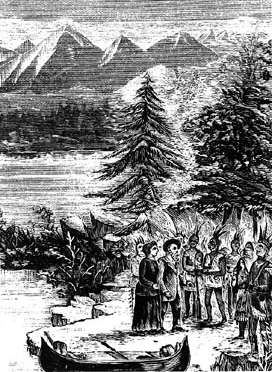Marie-Anne Gaboury facts for kids
Quick facts for kids
Marie-Anne Gaboury
|
|
|---|---|
| Born | 15 August 1780 Maskinongé, Quebec
|
| Died | 14 December 1875 (aged 95) St. Boniface, Manitoba
|
| Occupation | mother, settler |
Marie-Anne Lagimodière (born Gaboury) was an amazing French-Canadian woman. She lived from August 15, 1780, to December 14, 1875. She is famous for two main reasons: she was the grandmother of Louis Riel, a very important figure in Canadian history. She was also the first woman of European background to travel and make her home in what we now call Western Canada.
Contents
Early Life and Marriage
Marie-Anne Gaboury was born in a small village called Maskinongé, Quebec. This village is close to Trois-Rivières. When she was a young woman, she helped manage a priest's house there.
On April 21, 1806, she married Jean-Baptiste Lagimodière. Jean-Baptiste was from a nearby town called Saint-Ours. He was a "coureur des bois," which means a "runner of the woods." These were brave men who traveled far to trade furs for the Hudson's Bay Company. This company was very active in a huge area called Rupert's Land.
Journey to Western Canada
Right after their wedding, Marie-Anne did something very unusual for her time. She decided to travel west with her new husband. They first went to where the Assiniboine River and Red Rivers meet. This area later became the Red River Colony and is now Winnipeg, Manitoba.
They spent their first winter in a Métis camp near Pembina, North Dakota. This area was under British control back then. On January 6, 1807, their first child was born there.
Adventures on the Prairies
The next spring, the Lagimodières moved to the Saskatchewan River valley. They settled in what is now northern Saskatchewan. They lived a semi-nomadic life until 1811, moving around with other French-Canadian trappers and their Indigenous wives.
Marie-Anne often joined her husband on trapping and buffalo hunting trips. Sometimes, they traveled as far west as Alberta. Once, her horse bolted towards a herd of buffalo, and her second child was born right on the open prairie. Another time, she bravely fought and shot a large bear that attacked one of their friends.
Facing Challenges
One time, while trapping, their family was captured by Tsuu T'ina tribesmen. This happened because of their connection with local Cree people. They managed to escape on horseback, but they were chased for five days. Finally, they reached safety at Fort des Prairie, near modern Edmonton, Alberta.
Before marrying Marie-Anne, Jean-Baptiste had children with an Indigenous woman. Marie-Anne was kind and accepted these children into their family. The Lagimodières generally had good relationships with the Aboriginal peoples they met. Marie-Anne was often a source of curiosity because she was usually the first white woman people had ever seen. Some even thought she had special powers!
Settling at Red River
In 1812, the Lagimodières heard that Lord Selkirk was starting a permanent settlement at the Red River. They returned to help build the new Red River Colony.
The early years of the settlement were difficult. There were conflicts between the Hudson's Bay Company (HBC) and its rival, the North West Company. This led to events like the Battle of Seven Oaks in 1816.
A Long Journey for News
The Lagimodières tried to stay out of the fighting. However, Jean-Baptiste was asked by an HBC leader, Colin Robertson, to deliver important news to Lord Selkirk. Over the winter of 1815–1816, Jean-Baptiste traveled over 2,900 kilometers (about 1,800 miles) on horseback and on foot to complete this mission.
While he was gone, Marie-Anne had to find shelter with Indigenous tribes when the North West Company took over Fort Douglas. Jean-Baptiste was captured by the Nor'Westers on his way back. He was held prisoner in Fort William until August 1816. The family was finally reunited in September 1816, after the troubles had calmed down.
A New Home and Legacy
To thank him for his service, Lord Selkirk gave Jean-Baptiste a piece of land near the Red River. The Lagimodières built a successful home there and lived for many years. They had six more children. One of them, Julie Lagimodière, born in 1822, would become the mother of Louis Riel.
Marie-Anne lived to be 95 years old, passing away in 1875. She saw Manitoba become part of Canadian Confederation. This happened after Louis Riel's actions during the Red River Rebellion of 1869–1870.
Remembering Marie-Anne
Marie-Anne Lagimodière is sometimes called the "Grandmother of the Red River." Many Métis people on the Canadian Prairies can trace their family history back to her.
A French immersion elementary school in St. Vital, Winnipeg, is named École Marie-Anne-Gaboury in her honor. There is also a street, Rue Marie Anne Gaboury, in Bonnie Doon, Edmonton, Alberta. This street is home to the French-language part of the University of Alberta, called Campus Saint-Jean.
In 1978, a Canadian movie called Marie-Anne told a story about her life.
See also
- Isobel Gunn, an HBC worker who traveled to Rupert's Land disguised as a man.


